What are Tape in hair extensions ?
Tape-in hair extensions are a popular type of semi-permanent hair extensions that are known for their lightweight and discreet nature. Here’s a detailed overview:
What Are Tape-In Hair Extensions?
Construction:
Wefts: Tape-in extensions come in wefts, which are small sections of hair attached to a thin, adhesive tape strip.
Tape: The tape used is typically a medical-grade adhesive that is safe for skin and hair. It is strong enough to hold the extensions securely in place for several weeks.
Materials:
Human Hair: Most high-quality tape-in extensions are made from 100% human hair, which allows for a natural look and feel. They can be styled, colored, and treated like natural hair.
Synthetic Hair: There are also synthetic options, which are usually less expensive but cannot be styled with heat or colored.
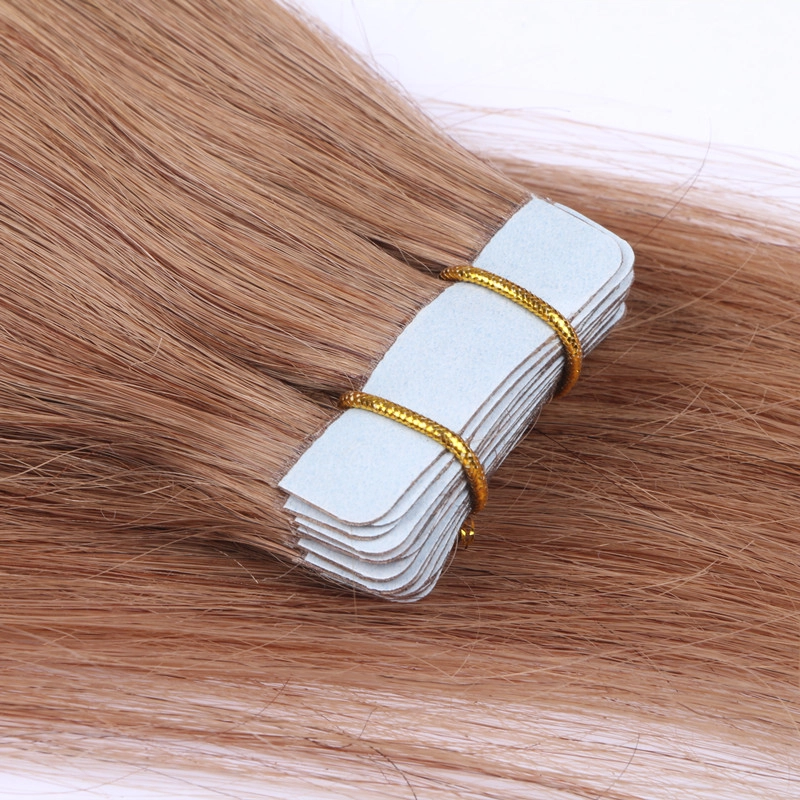
Application Process
Preparation:
The natural hair is washed and dried thoroughly to ensure it is clean and free of oils, which helps the adhesive bond better.
Placement:
Sandwich Method: Small sections of the natural hair are placed between two wefts of tape-in extensions, creating a "sandwich." The adhesive sides face each other, securing the natural hair in between.
Alignment: Proper alignment and spacing are crucial to ensure the extensions lie flat against the scalp and blend seamlessly with natural hair.
Time:
The application process typically takes about 1 to 2 hours, depending on the number of extensions being applied.
Maintenance and Care
Longevity:
Tape-in extensions can last between 6 to 8 weeks with proper care. After this period, they need to be removed and re-applied closer to the scalp as the natural hair grows out.
Washing:
Use sulfate-free shampoos and conditioners to prevent weakening the adhesive bond. Avoid heavy conditioners near the roots where the tape is applied.
Styling:
Extensions can be styled like natural hair but should be handled gently to avoid tugging at the adhesive bonds.
Removal:
A special adhesive remover is used to dissolve the bond, allowing the extensions to be easily removed without damaging the natural hair. They can then be re-taped and re-applied if desired.
Advantages
Natural Look: They lie flat against the scalp, making them virtually undetectable.
Comfort: Lightweight and do not cause much strain on natural hair.
Versatility: Can be styled in various ways, including updos and braids.
Reusability: High-quality tape-in extensions can be reused multiple times with proper care.
Disadvantages
Maintenance: Requires regular upkeep and professional re-application.
Cost: Initial investment can be high, especially for high-quality human hair extensions.
Care Restrictions: Need to be cautious with products used on hair to avoid damaging the adhesive.
Tape-in hair extensions offer a great balance between the ease of clip-in extensions and the permanence of more long-term solutions like fusion or sew-in extensions. They are favored for their natural appearance, comfort, and versatility.
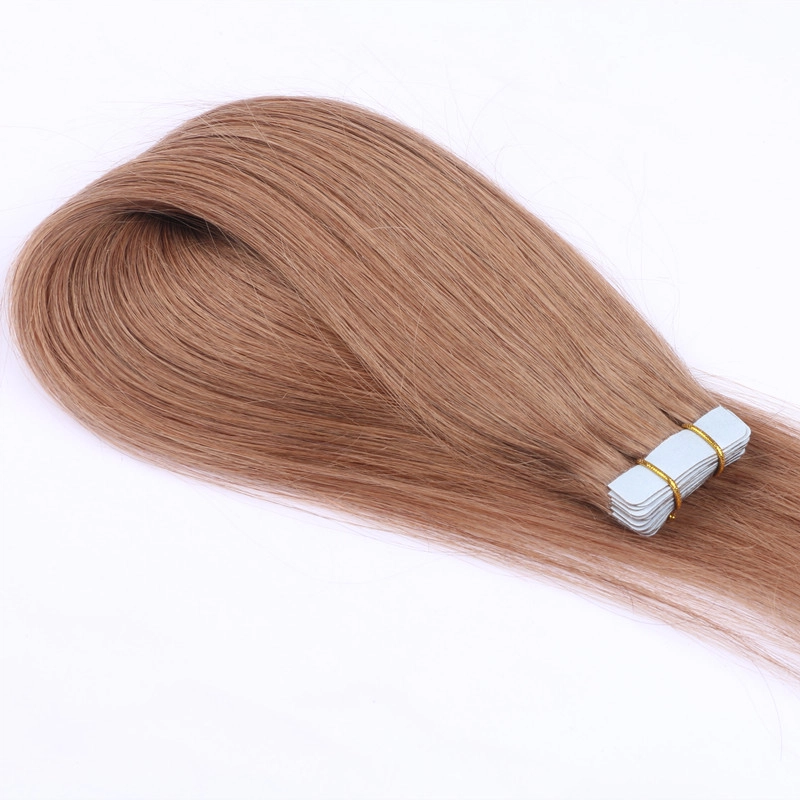
Tape in hair extensions pros and cons
tape-in hair extensions have their own set of advantages and disadvantages:
Pros:
Natural Look: Tape-in extensions lie flat against the scalp, making them appear more natural and seamless compared to bulkier extension types.
Comfortable: They are lightweight and typically more comfortable to wear than other types of extensions like sew-in or fusion extensions.
Versatility: Tape-ins can be styled just like natural hair, including curling, straightening, and even coloring (for human hair extensions).
Longevity: With proper care, tape-in extensions can last for several weeks before needing to be re-applied.
Low Maintenance: Once applied, they require minimal maintenance other than regular washing and styling.
Reusability: High-quality tape-in extensions can be reused multiple times, which can help offset their initial cost.
Cons:
Professional Application: Tape-in extensions must be applied by a trained professional to ensure they are properly placed and secured, which can add to the overall cost.
Potential Damage: Incorrect application or removal can cause damage to the natural hair, including breakage or traction alopecia.
Limited Lifespan: Although they can last for several weeks, tape-in extensions need to be removed and reapplied as the natural hair grows, which requires additional salon visits and maintenance.
Cost: High-quality tape-in extensions made from human hair can be expensive, especially when factoring in the cost of professional application and maintenance.
Care Restrictions: Certain hair care products and styling techniques may weaken the adhesive bond, leading to premature slippage or damage to the extensions.
Despite these drawbacks, many people find tape-in extensions to be a convenient and effective way to add length, volume, and versatility to their hair without the commitment of more permanent methods. It's essential to weigh these pros and cons carefully and consult with a hairstylist to determine if tape-in extensions are the right choice for your needs and lifestyle.
198336588.webp)
Are tape in extensions bad for your hair?
Tape-in hair extensions have become a go-to solution for many individuals seeking to add length, volume, and versatility to their hairstyles. However, there's ongoing debate about whether tape-in extensions have negative effects on natural hair health. In this article, we'll delve into this topic to uncover the truth behind the question: Are tape-in extensions bad for your hair?
Understanding Tape-In Hair Extensions:
Tape-in hair extensions are semi-permanent extensions that are attached to natural hair using medical-grade adhesive tapes. They offer a relatively quick and non-invasive method for achieving desired hair transformations.
Addressing Concerns:
Myth: Tape-in extensions cause hair damage.
Fact: When applied and maintained correctly, tape-in extensions shouldn't cause significant damage to natural hair. Proper installation by a skilled professional and gentle removal techniques are essential to minimize potential damage.
Myth: Tape-in extensions lead to hair breakage and thinning.
Fact: While improper installation or removal can potentially cause hair breakage, tape-in extensions themselves don't inherently cause thinning or breakage. Careful application and removal, along with regular maintenance, can help mitigate these risks.
Myth: Tape-in extensions are uncomfortable and irritate the scalp.
Fact: Some individuals may experience initial discomfort or irritation during the adjustment period. However, with proper application and adherence to maintenance routines, tape-in extensions can be comfortable and generally well-tolerated.
Myth: Tape-in extensions require excessive maintenance.
Fact: While tape-in extensions do require regular maintenance, such as reapplication every few weeks and proper care routines, they don't typically demand more upkeep than other extension methods. Following recommended maintenance practices is key to ensuring the longevity and health of both the extensions and natural hair.
Myth: Tape-in extensions aren't suitable for all hair types.
Fact: Tape-in extensions can be suitable for various hair types, including fine, medium, and thick hair. However, it's essential to consult with a hairstyling professional to determine the most suitable extension method and products for individual hair needs.
In conclusion, tape-in hair extensions can be a valuable tool for achieving desired hair transformations without compromising natural hair health when used correctly. While concerns about potential damage exist, adherence to proper installation, maintenance, and removal practices can minimize risks and promote overall hair health. Consulting with experienced professionals and following recommended care routines are essential steps to ensure a positive tape-in extension experience. Ultimately, tape-in extensions can offer a versatile and stylish solution for enhancing your hairstyle while maintaining the integrity of your natural hair.
How to Wear tape in hair extensions?
here's a detailed step-by-step guide on how to wear tape-in hair extensions:
Preparation:
Choose Extensions:
Select tape-in hair extensions that match your natural hair color and texture for the most seamless blend.
Wash Hair:
Start by washing your natural hair with a sulfate-free shampoo and conditioner to ensure it's clean and free of any oils or residue.
Dry Hair:
Completely dry your hair using a blow dryer or let it air dry naturally. Make sure your hair is entirely dry before applying the extensions to ensure a secure bond.
Application:
Section Hair:
Part your hair horizontally about 1-2 inches above the nape of your neck and clip the rest of your hair above the part to keep it out of the way.
Prepare Extensions:
Remove the protective backing from one side of the adhesive tape on a tape-in extension weft.
Sandwich a thin section of your natural hair between two tape-in extension wefts, ensuring the adhesive sides are facing each other.
Placement:
Press the extension firmly against your natural hair, starting from the roots and working your way down to the ends.
Ensure the extension is aligned parallel to your part and sits flat against your scalp without any visible gaps.
Repeat:
Continue applying tape-in extensions in horizontal sections, working your way up towards the crown of your head.
Leave a small gap between each row of extensions to allow for natural movement and prevent discomfort.
Blend:
Once all the extensions are applied, release the clipped-up section of your hair and blend it with the extensions by gently combing or brushing them together.
Styling:
Style as Desired:
You can style your hair as usual with tape-in extensions, including curling, straightening, or braiding.
Avoid applying direct heat to the adhesive area to prevent weakening the bond.
Care:
Use sulfate-free hair care products to maintain the longevity of the extensions.
Be gentle when brushing or combing your hair to prevent tugging on the extensions and causing damage.
Maintenance:
Regular Maintenance:
Tape-in extensions typically last 6-8 weeks before needing to be removed and reapplied closer to the scalp as your natural hair grows.
Schedule regular maintenance appointments with a professional stylist to ensure the extensions stay securely in place.
Removal:
To remove tape-in extensions, apply a specialized adhesive remover to dissolve the bond without damaging your natural hair.
Gently peel the extensions away from your hair, starting from the roots and working towards the ends.
Reapplication:
After removing the extensions, clean the adhesive residue from the tape strips and reapply them closer to the scalp for a fresh installation.
By following these steps, you can effectively wear tape-in hair extensions to add length, volume, and versatility to your natural hair while achieving a seamless and natural-looking result.
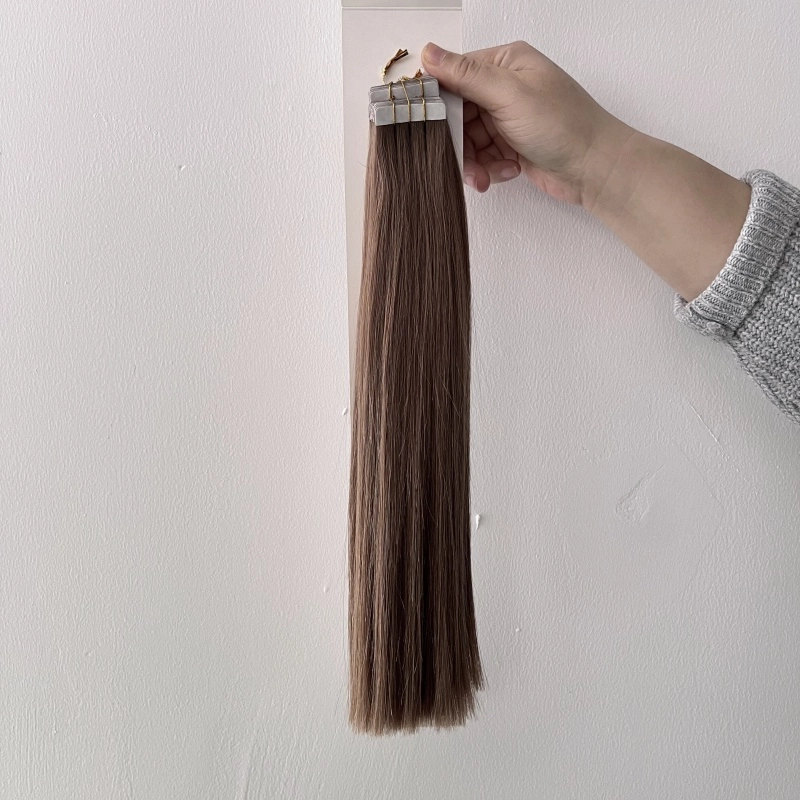
Comparison with other hair extensions
Comparing tape-in hair extensions to other types of hair extensions, such as clip-in, fusion, and sew-in, reveals their unique advantages and disadvantages:
1. Tape-in Hair Extensions vs. Clip-in Hair Extensions:
Tape-in Hair Extensions:
Pros:
More durable: Tape-in extensions can last 6-8 weeks, growing out with the natural hair.
More natural: They lie closer to the scalp, resulting in a more natural appearance.
More comfortable: They don't require clips or pins, making them more comfortable to wear.
Cons:
Professional installation required: Installation requires professional skill and may need professional assistance.
Higher maintenance cost: Maintenance requires regular salon visits, making them more costly.
Clip-in Hair Extensions:
Pros:
Easy to use: No professional installation required, can be installed and removed at home.
Lower cost: Generally lower cost compared to tape-in extensions.
Removable: Can be installed and removed as needed.
Cons:
Short-term: Cannot be worn for extended periods, need to be taken out daily.
Visibility: Clips or pins may be visible, especially in the lower sections of hair.
2. Tape-in Hair Extensions vs. Fusion Hair Extensions:
Tape-in Hair Extensions:
Pros:
Lower damage: Compared to fusion extensions, tape-in extensions cause less damage to the hair.
Easier installation: Installation is relatively simple, no need for heat tools.
Lower maintenance cost: Maintenance costs may be lower compared to fusion.
Cons:
Durability: Require more frequent reinstallation compared to fusion extensions.
Fusion Hair Extensions:
Pros:
Long-lasting: Fusion extensions can last 3-6 months, without the need for frequent reinstallation.
Better coverage: May provide better scalp coverage for those with thinning hair.
No glue needed: Unlike tape-in extensions, fusion extensions don't require glue, potentially better for those allergic to adhesives.
Cons:
Higher maintenance cost: Maintenance costs may be higher, requiring more frequent salon visits.
More damage: Compared to tape-in extensions, fusion extensions may cause more damage as they require heat tools for installation.
3. Tape-in Hair Extensions vs. Sew-in Hair Extensions:
Tape-in Hair Extensions:
Pros:
More natural: Compared to sew-in extensions, tape-in extensions lie closer to the scalp for a more natural look.
More comfortable: Relatively lightweight and comfortable, without excessive tension.
More convenient: Installation and removal are relatively easier, requiring less time.
Cons:
Shorter lifespan: Require more frequent reinstallation compared to sew-in extensions.
Sew-in Hair Extensions:
Pros:
Longer-lasting: Sew-in extensions can last 6-8 weeks, similar to tape-in extensions.
Better for dense hair: May provide better coverage for those with thicker hair.
Lower maintenance cost: Maintenance costs may be lower compared to tape-in extensions.
Cons:
More complex installation: Requires more time and skill compared to tape-in extensions.
Longer installation time: Installation may take longer compared to tape-in extensions.
By understanding the pros and cons of each type of hair extension, individuals can make a more informed decision based on their needs and preferences.
Notes on Tape in hair extensions
Potential users should consider several important factors to make a wise decision regarding hair extensions:
1. Hair Type:
Texture: Consider your natural hair texture when choosing extensions. Match the texture as closely as possible to ensure seamless blending.
Density: If you have thin or sparse hair, lighter extensions like tape-ins may be more suitable. For thicker hair, sew-in or fusion extensions could provide better coverage.
Condition: Healthy hair is essential for successful extension installation. Evaluate your hair's condition and address any damage or issues before adding extensions.
2. Budget:
Initial Cost: Different types of extensions vary in price. Clip-in extensions are generally more affordable upfront, while fusion extensions tend to be more expensive due to the labor-intensive installation process.
Maintenance Cost: Consider the ongoing maintenance expenses, including salon visits for reinstallation and special hair care products.
3. Maintenance Ability:
Time Commitment: Some extensions require more frequent maintenance than others. Clip-in extensions offer the flexibility of easy removal, while tape-ins and sew-ins need regular upkeep to maintain their appearance.
Skill Level: Certain types of extensions, like clip-ins, can be managed at home with minimal skill. Others, such as fusion or sew-in extensions, require professional installation and removal.
4. Lifestyle:
Activity Level: Consider your lifestyle and activities. If you're active or swim frequently, extensions that are securely attached, like tape-ins or sew-ins, may be more suitable.
Styling Preferences: Different extension types offer varying styling versatility. Clip-in extensions allow for quick changes, while fusion or sew-in extensions offer more long-term styling options.
5. Long-Term Goals:
Temporary vs. Permanent: Determine whether you're looking for a temporary or more permanent solution. Clip-in extensions are ideal for occasional use, while fusion or sew-in extensions provide longer-lasting results.
Hair Health: Consider the impact of extensions on your natural hair health. Extensions that cause minimal damage, like tape-ins, may be preferable if you prioritize maintaining the health of your natural hair.
By carefully evaluating these factors, potential users can choose the most suitable type of hair extensions that align with their needs, preferences, and lifestyle, ensuring a positive and satisfying experience.
Recommendations for tape in hair extensions
Here are some suggestions to help users make better use of tape-in hair extensions, including how to choose, maintain, and care for them after installation:
1. How to Choose:
Selecting the right color and texture: Ensure to choose tape-in hair extensions that match your natural hair color and texture for the most natural look.
Consider hair length and density: If your hair is sparse or short, lighter extensions may be more suitable to avoid excessive pressure or tension.
Opt for quality products: Choose high-quality tape-in hair extensions that use medical-grade adhesive and have soft and transparent tape tabs to ensure comfort and a natural appearance.
2. Maintenance After Installation:
Proper cleansing: Use mild, sulfate-free shampoo and conditioner to clean your hair, avoiding oily or moisturizing products on the adhesive areas to prevent affecting the bond.
Gentle combing: Use a wide-tooth comb to gently comb through the hair, starting from the ends and gradually working upward, avoiding applying too much tension on the adhesive area.
Avoid direct heat contact: Try to avoid direct contact of heat tools with the adhesive area of the tape-in hair extensions to prevent damage to the adhesive.
3. Regular Maintenance:
Regular salon visits: Visit the salon regularly for check-ups and maintenance as advised by your hairstylist to ensure the extensions and natural hair are in good condition.
Periodic reapplication of adhesive: As natural hair grows, tape-in hair extensions may require periodic reapplication of adhesive, typically every 6-8 weeks.
Avoid over manipulation: Avoid excessive pulling or handling of the extensions to prevent damage to the adhesive area or hair breakage.
4. Safe Usage:
Avoid frequent pulling: Try to avoid frequent manipulation or pulling of the extensions to prevent hair damage or adhesive detachment.
Avoid oily products: Avoid using oily or greasy products on the adhesive area, as this may weaken the adhesive bond.
Handle with care: Handle the extensions with care, avoiding tugging or pulling on them to prevent damage or detachment.
By following these suggestions, users can make better use of tape-in hair extensions, maintaining their appearance and quality while ensuring they blend seamlessly with natural hair, while minimizing damage and discomfort.
In conclusion, it's important to encourage readers to make decisions based on their own needs and preferences when it comes to tape-in hair extensions. While tape-in extensions offer various benefits and considerations, ultimately, the choice depends on individual circumstances.
By understanding the pros and cons outlined in this article, readers can make informed decisions that align with their hair type, lifestyle, and budget. However, it's also crucial to emphasize the value of seeking professional advice when needed. Hairstylists can provide personalized recommendations and guidance tailored to each individual's unique situation.
With this structured information, readers can gain a clear understanding of the advantages and disadvantages of tape-in hair extensions, empowering them to make wise choices that meet their specific needs and preferences.
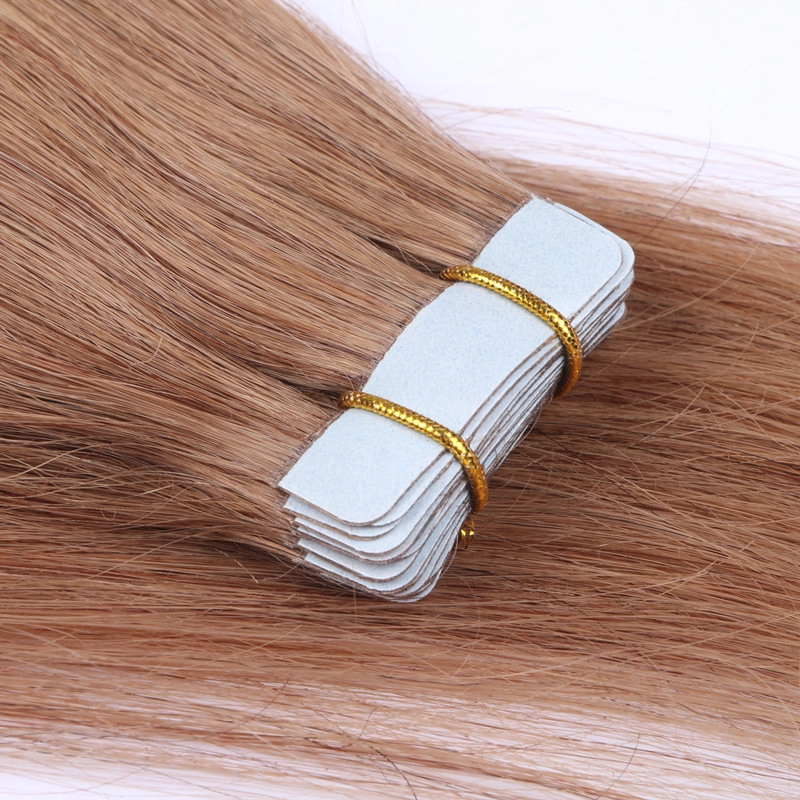
394.webp)
266.webp)
179.webp)
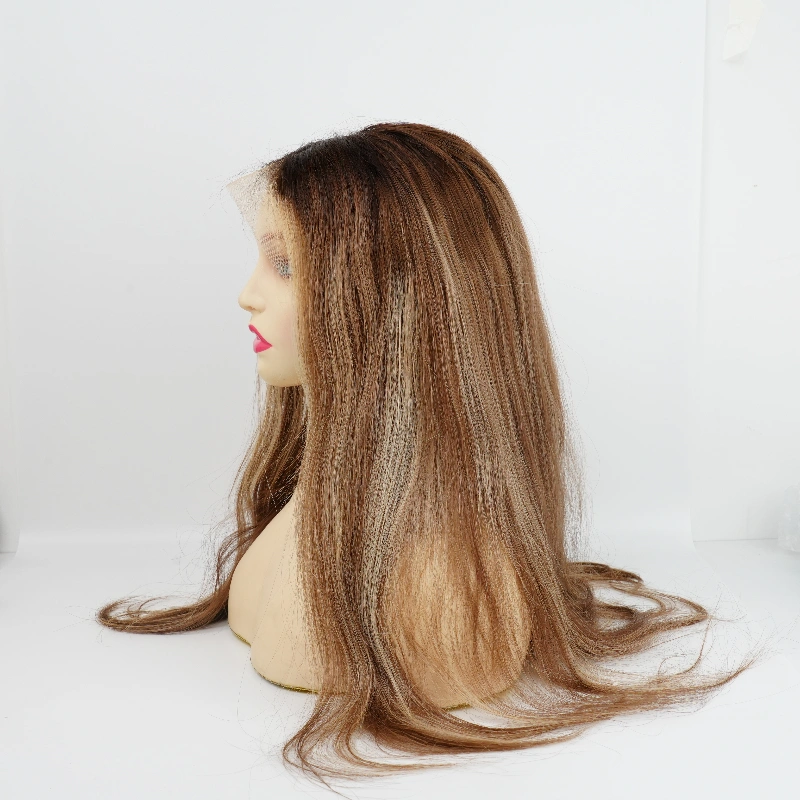
170.webp)
268.webp)